Fishing Mud Lines For Big Fish

By: Garner Reid
MUD LINES ARE EXCELLENT PLACES FOR FISH TO HIDE.
I split my guiding year in half, targeting trout from fall to spring and the rest of the year pursuing summer run striped bass in my local river systems. River run stripers offer their own unique set of challenges for the angler, and definitely for the guide.
When someone gets in my boat for a day of striper fishing, one of the first things I try to explain is where these fish like to hold. I tell them to start out like they are streamer fishing for a big brown trout. When someone is pursuing a new species of fish, like stripers in a river, finding that common thread is the key to angling success.
Just the other week I had the pleasure of guiding a new client who was quite an accomplished angler. Having caught many fish in all the exotic locations that are on my personal bucket list. As we floated down the river it quickly became evident this guy knew how to fish. He was ripping big streamers accurately into all the nasty stuff that a big fish ought to hold in.
This was producing a few nice schoolie sized stripes but nothing huge. Halfway through our float we approached a small feeder creek quartering in at a 45 degree angle to the left of the boat. Heavy rains the night before had the creek dumping chocolate milk into the river. Typically not what a fly fisherman likes to see.
The muddy creek water was thick like oil, being pushed up against the clean water by the current, which carried a defined wall of muddy water down the left side of the river for hundreds of yards.
I rowed the boat into position perpendicular to the creek mouth and dropped anchor, told the guy to make a big cast across the creek mouth and let his fly sink, followed with an aggressive retrieve. A few strips later
Trading in Desire
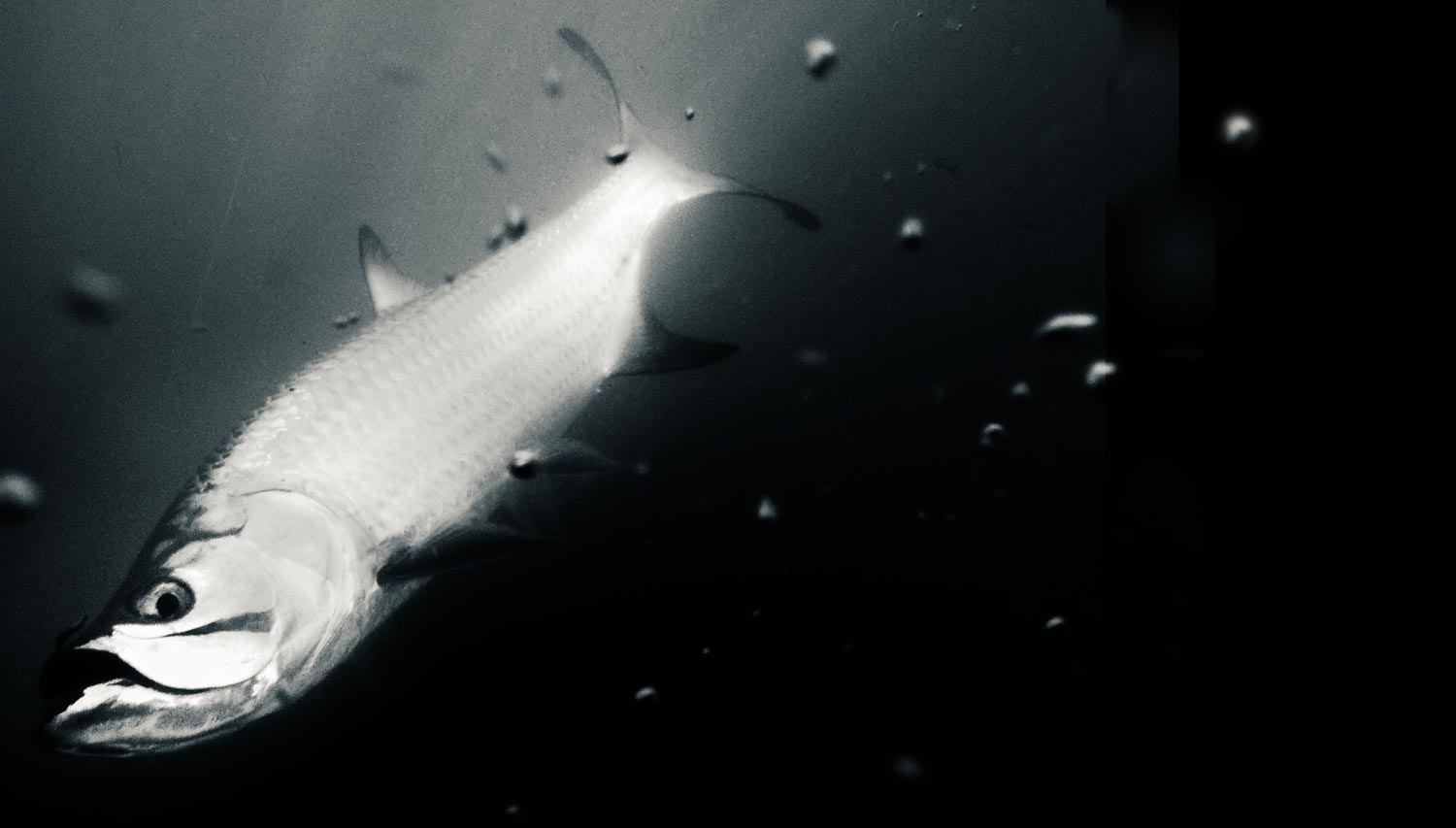
By Lauren Holt
“OKAY. SEE THAT DARK SPOT? ABOUT 200 FEET OUT. 2 O’CLOCK.”
I squint that direction, worry my lower lip with my teeth, cup my cheekbones and the bill of my cap to help cut the glare of the mid-afternoon sun sneaking past the edge of my sunglasses, willing my eyes and my brain to separate the slivers of dark I thought I could see from the shadows of waves and the coral a few feet below. Slowly, giant shadowy shapes emerge from the confusion.
“Look for movement. See them? There are four – no – five in this string.”
It’s a perfect day in the Keys, all three criteria for prime tarpon fishing in my favor. Bright sun; no clouds. Good water. Just enough of a breeze to encourage row after row of little waves to rise and sink in concert, more short fat silver little pyramids than “waves” proper. And we had fish. Hundreds and hundreds of fish.
I spot them and nod. If tarpon can amble, these were, and on the same path toward the skiff others had taken all day.
“Okay now. I’m gonna spin the boat. Hold tight.”
It was my first day fishing on this trip and already I had shots at more tarpon than I had seen the whole year before. Strings like this one of just a few, others in much larger groups. Giant tarpon, smaller tarpon, “normal” tarpon. In lines and circles, veering toward us and away, guided by seams and edges and currents too subtle for my eyes to reliably pick out.
“You’ve got your fly ready? Your line cleared?”
I nod.
“Okay then. Just hang tight kiddo. You’re gonna get one of these.”
A thought breaks my focus, unbidden, certainly unwelcome: this is it – no one gets a whole trip’s worth of these conditions – if you’re gonna do this, you’ve gotta make it happen today.
“See that dark spot that isn’t moving? When they get there, I want you to make no more than two false casts and then drop your fly right on the lead fish’s back.”
I realize as they get closer that these fish are bigger than most we’ve seen. These were the fish I’d wanted to catch on a fly for half my life, since I traded the conventional tackle I grew up on in the ponds and streams and rivers and lakes that dot northwest Arkansas for a fly rod, a handful of feathers, and the salt.
Around that time, I saw my first picture of a giant tarpon, dwarfing the guy who caught it, its hinged trapdoor of a mouth open so wide it looked like the angler could’ve stepped inside it, and hanging from a corner, a fly. A fly! It reminded me of a scene from The Pink Panther that featured a man hopping around while standing in a giant fish, holding its jaws like he was using it in a sack race. So the whole scene in the picture struck me as a little bit absurd. I was bemused, incredulous, fascinated. And I knew I wanted to catch one someday. It didn’t have to be soon – there’s a shortage of salt water in Arkansas and my summers and winters at the local bakery weren’t going to magically transport this high school student to any coast – but I knew then I wanted to and would eventually catch a behemoth of my own. Every time I take a shot at a tarpon, I remember the moment I knew I wanted to catch one, and this shot was no different.
Though it feels like an eternity has passed, they’re finally 50 feet from the spot. 25. I let my fly go, see it suspended in the breeze as I look past it at the lead fish. One false cast, then another, and not for the first time it occurs to me how cool physics is, how when I double haul, I’m really just the human part of a catapult that hopes to launch a bunch of fur and feathers lashed to a hook where I want it to go. And this time it does, landing more or less where I’d hoped.
Strip – strip – strip.
Read More »Fly Fishing For Peacock Bass, Part 1
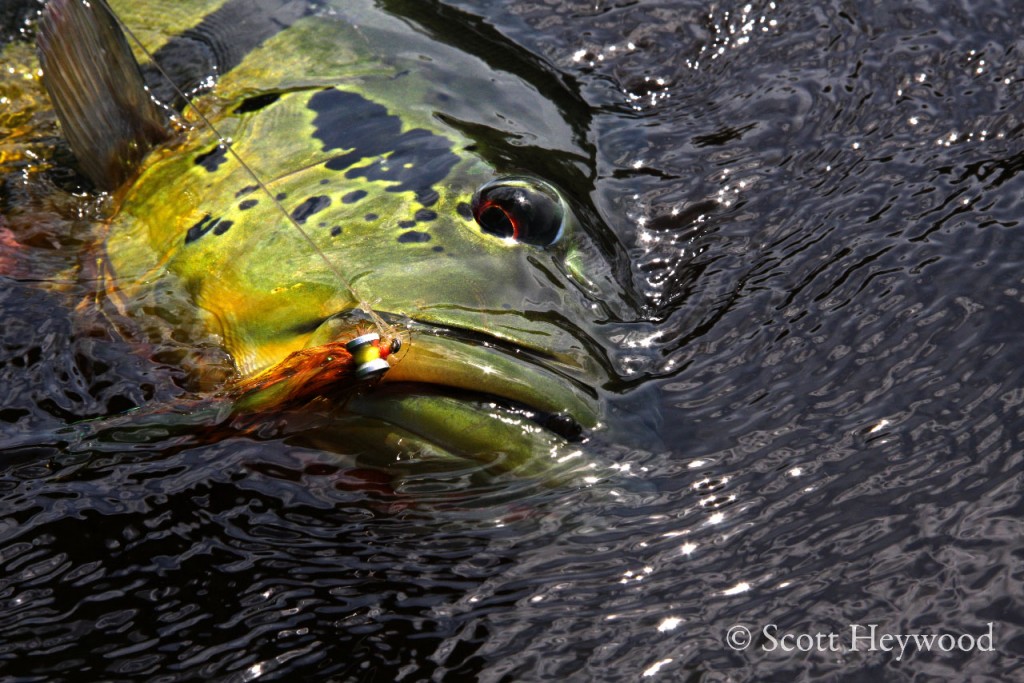
I’ve been very blessed to have fly fished many destinations around the world.
All have been amazing trips, but one destination in particular I hold close to my heart. Every time someone asks me what’s the coolest place I’ve fly fished, without any hesitation, I always reply fly fishing for peacock bass in the Amazon. Combine the extreme beauty and remoteness of the Amazon Basin with the opportunity to battle one of the most powerful freshwater gamefish on the planet, and it’s pretty easy to see why it ranks at the top of my list. That’s not even factoring in the other bonuses you’ll receive, like catching several other species of fish and witnessing all the diverse wildlife.
“While beginners always seem to catch fish, the persistent skilled angler wielding a precise cast is more often than not rewarded for his/her hard won mastery. Make a good sidearm cast between two logs under a tree and it might be rewarded. Hit that bit of flashing neon green or quickly reload to hit a laid-up chunk of muscle and madness 20 feet off the boat’s bow and it just might work. Peacock bass fishing is intriguing fishing. It is shoulder burning, forearm aching and finger cramping to be sure. There will be snags hooked, lines fouled and fish missed. It is at times maddening, frustrating and patience testing, but ultimately exhilarating, very satisfying and all consuming…and yes, as cliched as it might sound, addicting.” Scott Heywood
Making a trip to the Amazon used to be one of the most economical
Read More »Cat Island Bones
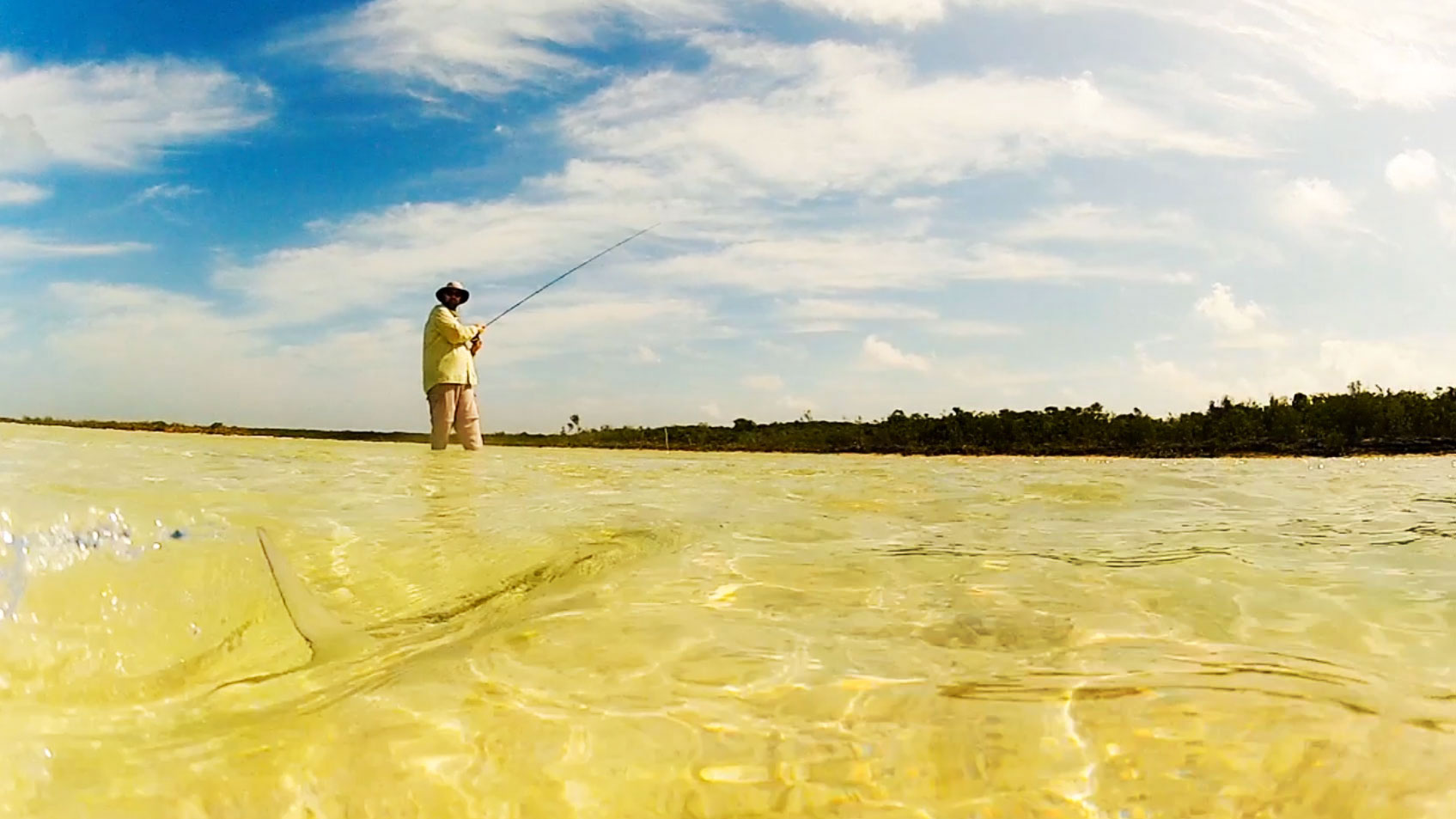
WHITE SAND, BLUE WATER, BONEFISH AND RUM. WHAT MORE DO YOU NEED?
Cat Island is not known as a bonefishing destination. It’s a quiet island with beautiful beaches, warm people and modest fishing opportunities, compared to its neighbors. It’s not South Andros or Bimini but it’s a place I have grown to love.
The flats fishing is purely a DIY scene. The fish are small but really spooky and that makes them rewarding to catch them. They are a food source for the locals, so the fish who are on the flats have earned that right. I take a kayak and paddle to some flats I know to spend the day wading. The bonefish are always good to me.
It was inevitable that I get a GoPro camera. I took it with me on my last trip to Cat Island and shot this video. So, have a click and enjoy five minutes of Cat Island Bones!
Read More »Simms G3 Guide Jacket and Flyweight Access Boot
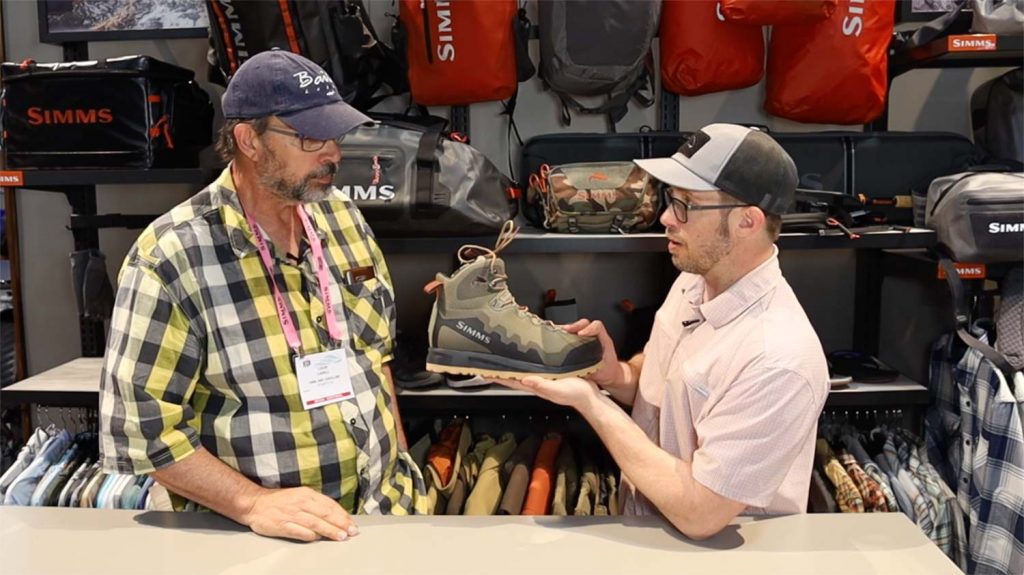
Some cool and very technical new gear from Simms. With the stellar redesign on the G3 Wader, Simms had to update the industry standard G3 Guide Jacket. It’s a smart and sharp looking update to an essential piece of kit we all love. The new Flyweight Access Boot, however, is something completely new. It weighs next to nothing and in the list of cool technical features is the Vibram Hydroflex sole, which may be the first rubber sole to actually work. Watch the video for all the details on the new G3 Guide Jacket and Flyweight Access Boot.
Read More »Bob Is A Hero
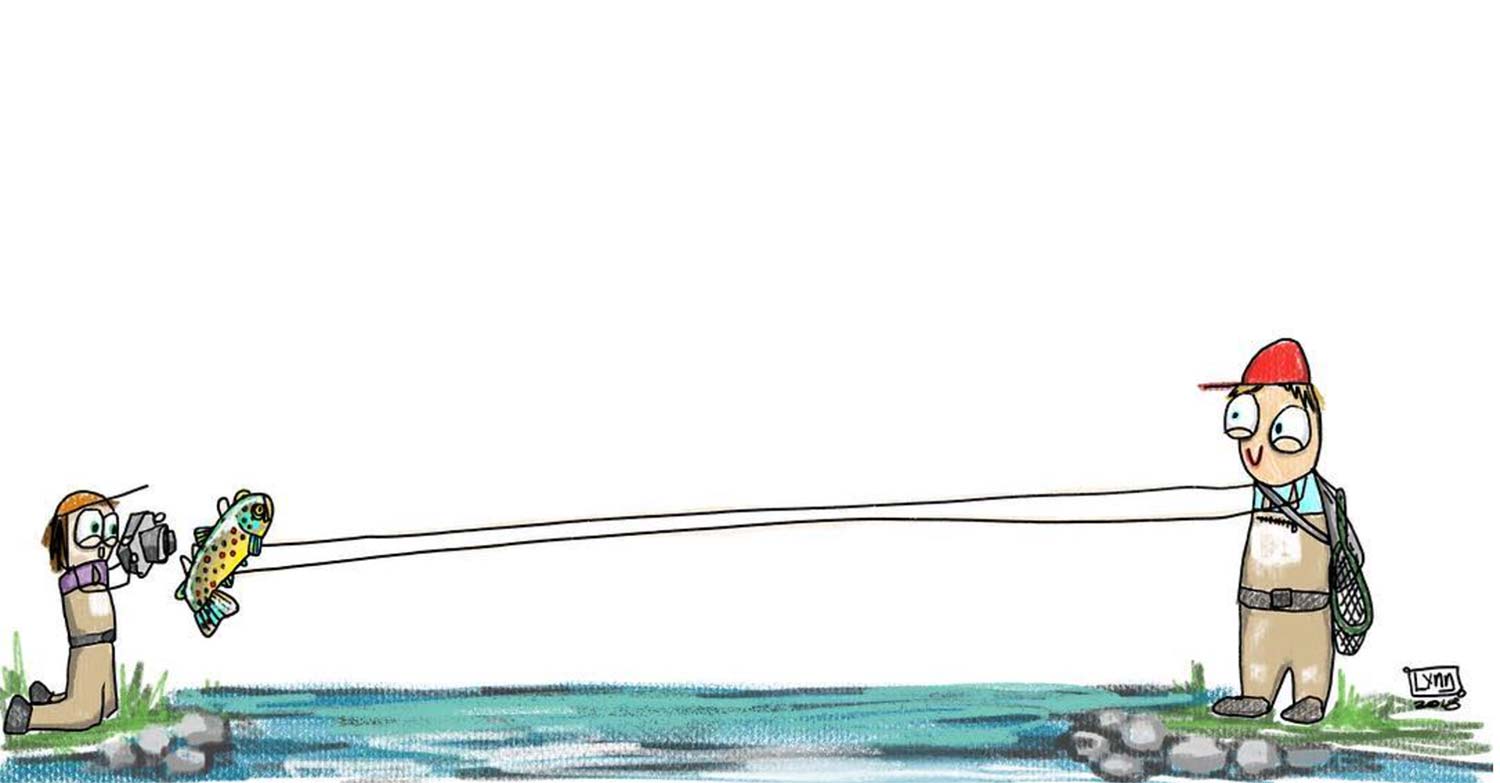
Bob knew how to get that perfect hero shot.
I think Andrea Larko has been following Justin and I around on the river. I guess the secret is out. Check out Bob and much more of Andrea’s work on Etsy.
Read More »Popping The Ball, Why Guides Release Fish
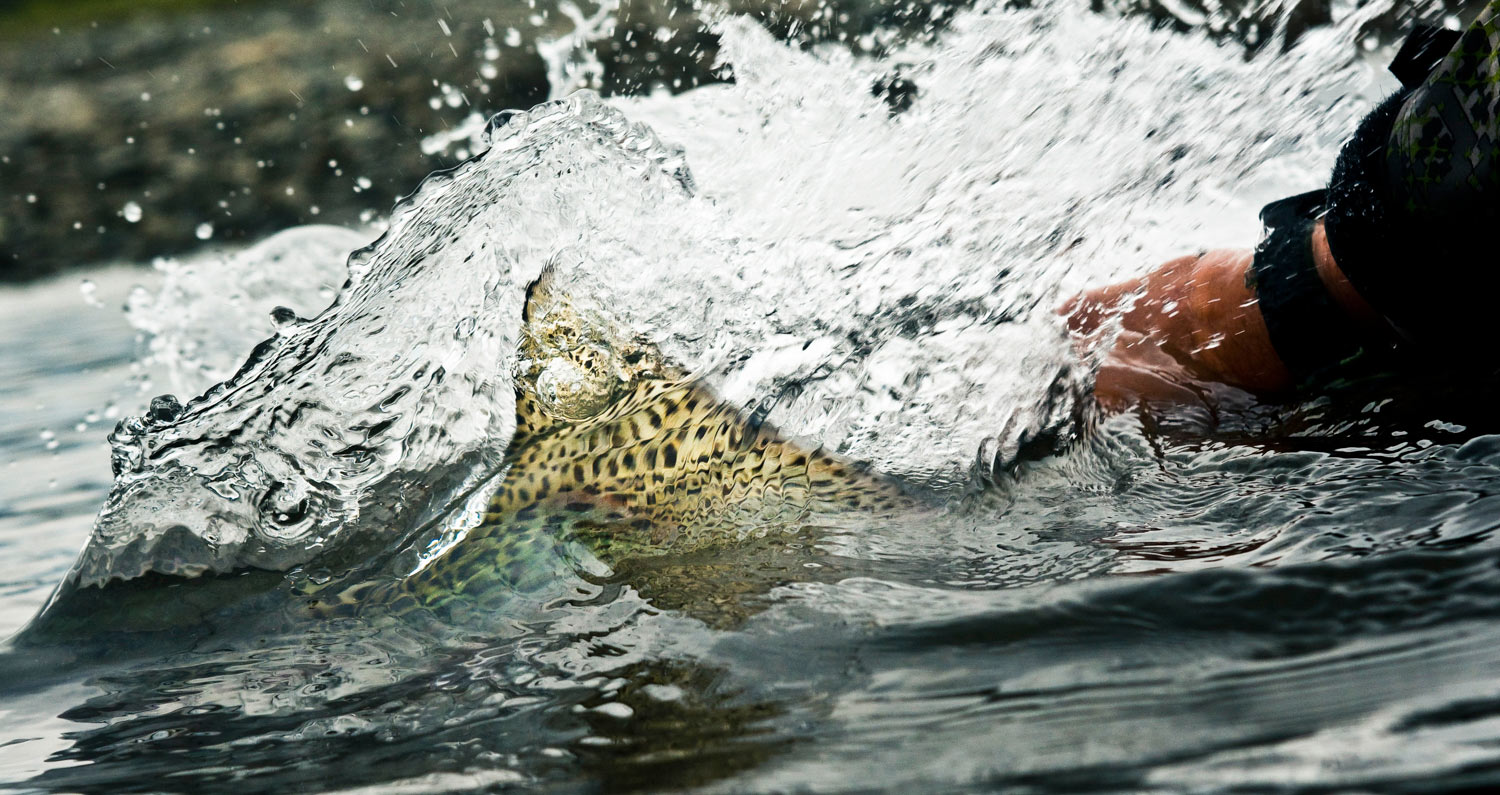
By Brian Kozminski
If you popped a basketball every time you make a basket, you might be missing the point.
It’s a burning issue, and hot topic across the midwest right now. Nothing new for me, really. I received a call from a potential client the other day, I was just getting done washing off the mud and cedar debris from the Adipose in the drive-thru car wash, so I decided to take the call. The kind lady first asked if I was Catch & Release?
“Well, of course I am, ma’am.”
“But we want to fish up there next week when we are up for vacation. Can’t we keep the fish we catch?” replied the lady.
I had to take the opportunity to explain myself. I am an advocate for C&R, but also believe there is a time and place for selective harvest—meaning taking out certain sized fish in a population that is self sustaining in order to ensure future healthy size class, whether warm water or cold water species.
“I would gladly take you fishing, but if I let you keep fish, that would not only deter the quality of guide trips next week, month and next year, but also, if the word got out that True North Trout catches and kills trout, I could quickly gain a negative reputation and lose potential clients. It works like this: if you popped a basketball every time you make a basket, you might be missing the point. The relaxation, the art of tying and fooling a fish on a fly, therein lies the reward and why we chase eight-inch brook trout with a three-weight rod. Fly fishing is about the peace, the serenity and the enjoyment of seeing the beauty in nature around us.”
“But what if we let the females go?” she retorted. “My husband and I would like to learn to fly fish.”
She was relentless. I felt backed into a corner. How can I turn around a possible learning situation for these anglers and for myself?
“I would be more than happy to take and show you how beautiful the river is and some fly fishing technique, but I won’t purposefully kill or take a fish home. Simply put, if you catch a nice 18-20″ trout, I know where he lives, and perhaps have the opportunity and chance to share catching that mature fish with future anglers, even a couple more times in a year, and next year, he is a 22-24″ fish. If we take him out of the ecosystem, there is zero percent chance of catching him again or that he will be a two-foot streamer crashing trophy next season.” the best I could come up with.
“Well, maybe. Let me talk with my husband, we would like to learn how to fly fish. Do you know any other guides that will let us keep our catch?” She is not giving up easily.
“I am sorry, I do not, sounds like you are looking more for a charter boat captain and would enjoy a trip on Lake Michigan trolling for salmon or lake trout.”
“Thank you. We will get back with you. Good Bye.”
“Thank you. I am sorry. I hope you understand. If we as guides killed every fish we catch, we wouldn’t have a job in a few short years, similar to a restaurant that gives away a lot of free drinks, they don’t manage the resource very well and end up dry.”
Scenario phone calls like this seem to pop up every other week or so. Kind of crazy when I think about it. What is driving this customer my way? Google Search shows TNT at top ten? Most of these anglers are from out of state. I understand the need to bring a fish home, a bit of a keepsake from Michigan, and understandable with our of state license fees. But these fees are exactly what helps keep Michigan an often sought fishing destination. What about where they are from? I see a trend in Ohio, Indiana, Illinois and even Georgia residents seeking a piece of our northern Michigan heaven. So I looked into these states and why the popularity.
First, The PURE MICHIGAN campaign. Laugh a little. I did. But a considerable
Read More »Shea Gunkel’s Radiation Baetis
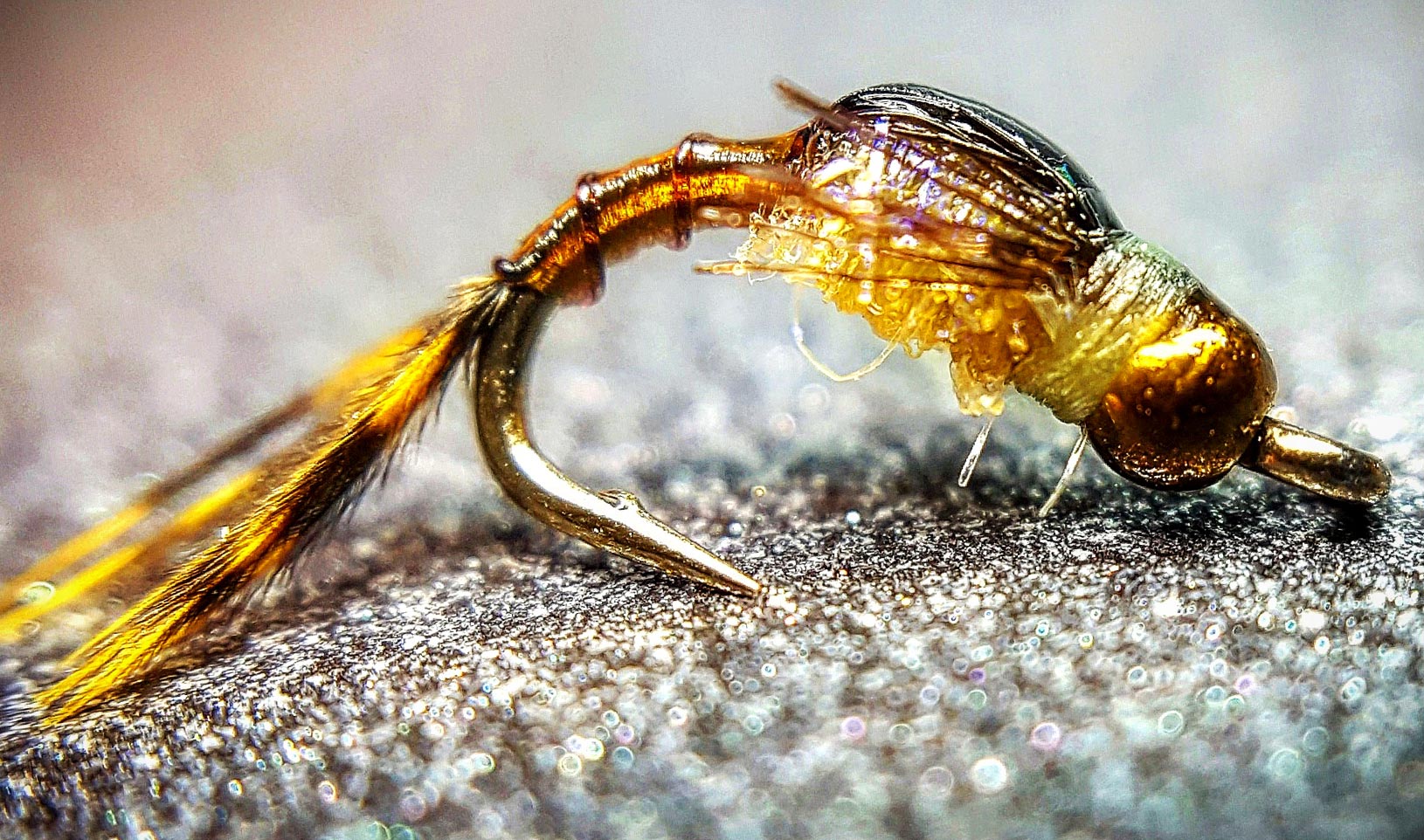
By Bob Reece
The creation of some fly patterns results purely from the need to fill a niche.
Others however, result from a blending of emotions and experience. This latter path of development leads signature Umpqua tyer Shea Gunkel to the creation of his Radiation Baetis.
Moms are in integral part in many of our lives. A couple years ago, Shea received news that his mom had been diagnosed with cancer. His heartfelt emotion drove him to create a new pattern, the original highlighted with pink, in an effort to raise awareness for cancer and show support for his mom.
The earlier versions of this bug were often pinned in hats and sweaters, where they made frequent trips to chemotherapy treatments. As time passed, Shea began to see the pattern in an additional light. After fishing it heavily and sharing samples with guides around Colorado, on the water success stories began to flow in. Shea then
Read More »New Orvis Pro Bootfoot Wader and Pro Boot with Hybrid Sole
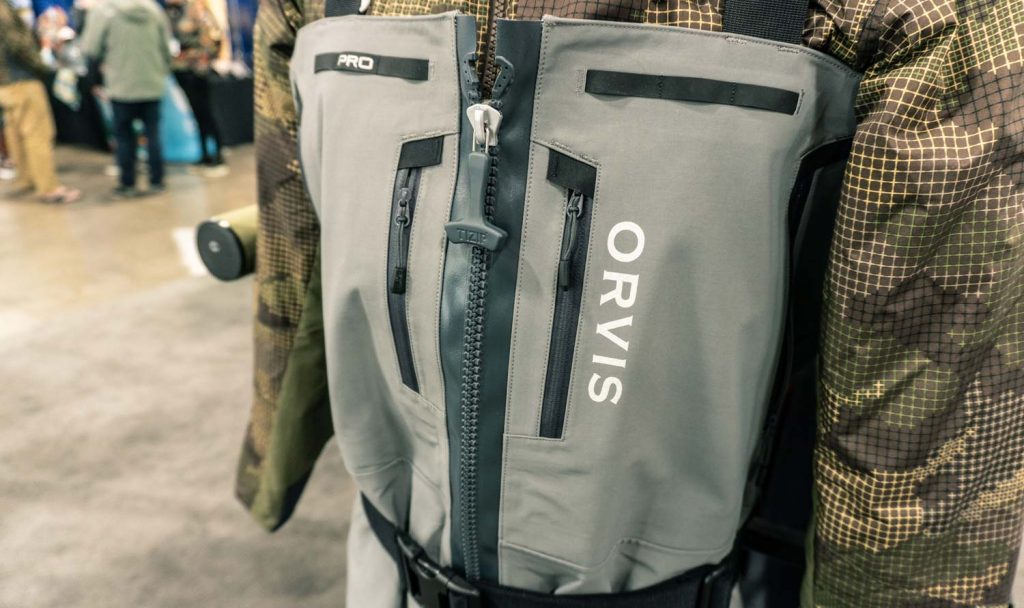
Check out the new waders and wading boots from Orvis. Orvis has a couple of new options this year for your wading excursions. The Pro Boot is now available with a new and improved BOA system, as well as a hybrid sole that combines felt and rubber. The new Pro Wader now comes in zip-front and boot foot, for extra warmth in the winter. Watch the video for all the details on new Orvis Pro Boots and Waders. Louis Cahill Gink & Gasoline www.ginkandgasoline.com hookups@ginkandgasoline.com
Read More »Don’t get yourself caught in a tight spot!
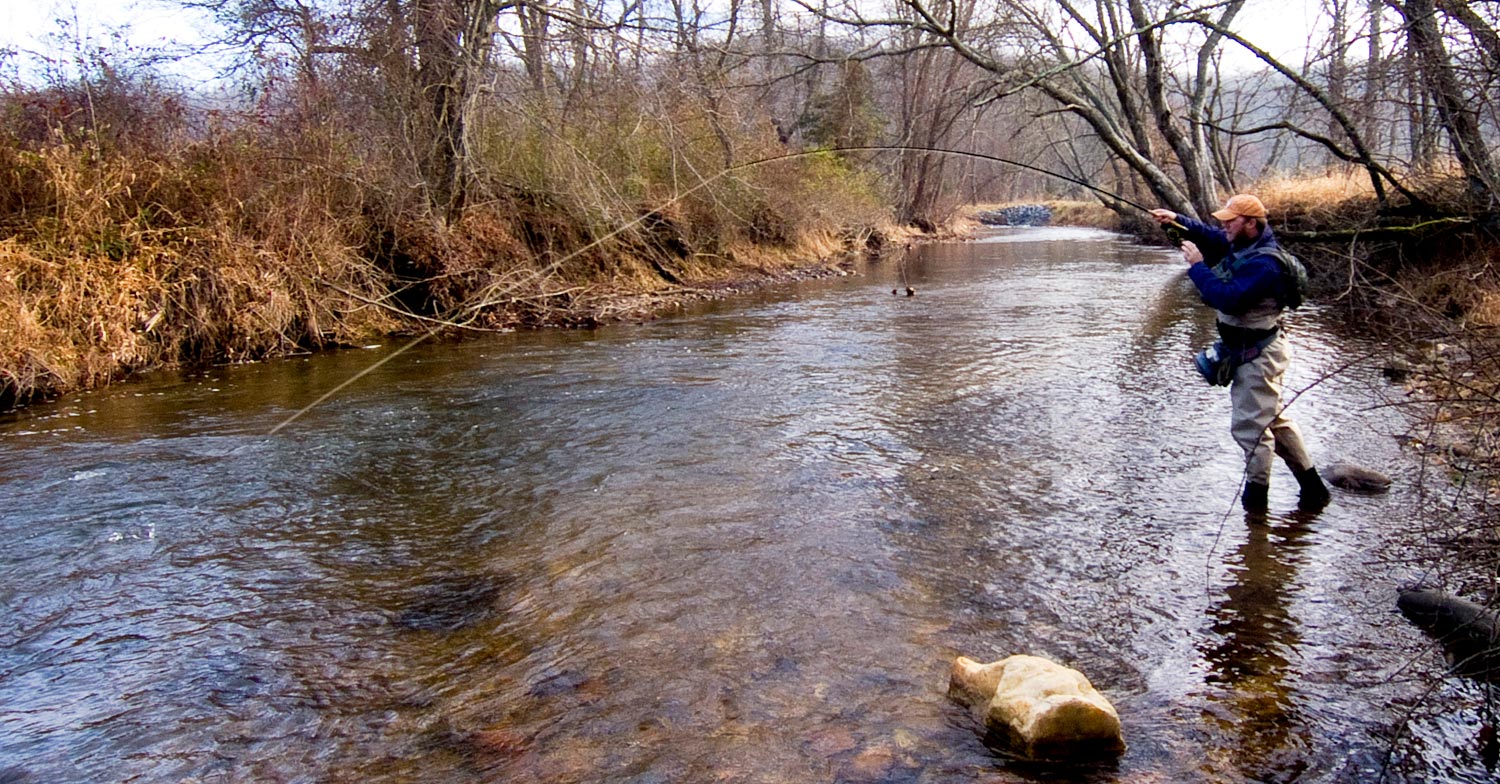
By Justin Pickett
“MY MOUTH SPEWED WITH EXPLETIVES. MY BUDDY’S FACE WAS BLANK. I KNEW THAT IT WAS THE RESULT OF SEVERAL POOR DECISIONS.”
Recently, I headed up north with a great friend of mine to fish a small stream in north Georgia. Over the past couple of years this destination had become one of our favorite pieces of water. The main reasons being the number of large brown trout found there, and how it seemed one of us would hook up with one these large residents every time we wet a line in its waters.
That Spring day was perfect. Cool temps. Cloudy skies. The water was just a bit stained from the rain the night prior.
We headed straight for the section of stream where, historically, we’ve had the best luck hooking up with some nice brown trout. Fishing our way up through this section, we were coming up empty handed. Only a couple of eager rainbows had bent our rods during the first couple of hours.
We typically fish together with alternating casts and different rigs. This has always proven successful, but today I decided to depart from our usual method and jump ahead of my fishing buddy. Straying further upstream, I figured we’d just holler at each other should we need help with something.
I approached a run that just looked fishy as hell. A shallow section of water dumped into a deep bucket and then cut under the far bank, which was lined with rhododendrons. At the tail of the run a tree branched out over the water providing shade and cover. It had trophy trout sanctuary written all over it.
My euro-rig that day consisted of a #6 black stonefly nymph, trailed by a #6 Vladi worm, and I had them tied to 3x and 4x fluoro tippet respectively. To say, I have confidence in this tandem on days where the water is stained, is an understatement.
On the second drift through the meat of this run, my rod translated a solid thump in the line. I lifted the rod tip and set the hook hard, and immediately I can feel
Read More »